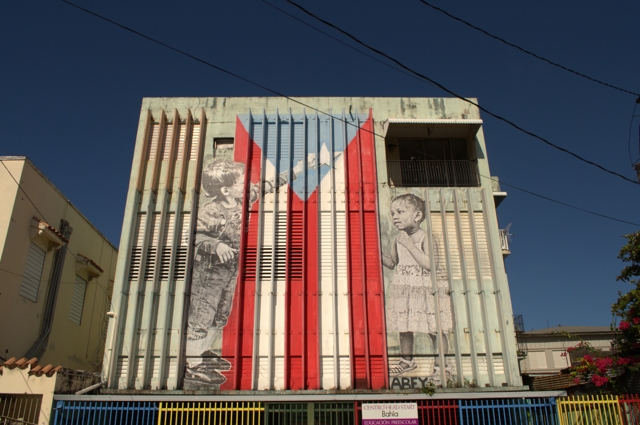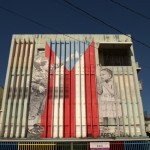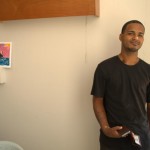
Publicado el 6 de abril de 2015 | Vice News
Por Samuel Oakford
Everywhere you go in Puerto Rico, people want to leave. “Why would I stay?” Jannette Sanchez, a 30-year-old law student at San Juan’s Interamerican University, asked VICE News during a recent trip to take stock of the increasingly dismal life in the United States’ most populous overseas territory. Sanchez, whose father once had a high-paying job at the now nearly insolvent government electrical company, ticked off the times she had been a victim of violence. With friends in Dallas — along with half a dozen other American cities — Sanchez plans to move to Texas immediately after graduating. “There are people here with master’s degrees and PhDs who work at Walmart part-time,” she said. “It’s a joke.”
Emigration has long been a pressure-release valve in Puerto Rico, ushering the discontented and unwanted off the island and avoiding a reckoning that might otherwise result if there weren’t an open border to the mainland US. Today it’s hard to see when it might stop. Pushed out by a stagnant economy and lack of opportunity — along with the drugs, crime, and endemic corruption that surround them — people are now leaving at a rate that rivals even the well-known migrations in the 1950s. Between mid-2010 and 2013, Puerto Rico saw a net emigration of 144,000 people — nearly 4 percent of its population. For the first time in history, stateside Puerto Ricans — 4.9 million — outnumber the 3.5 million who remain on the island.
The decision to leave is painful, but given the US passports carried by locals, it is often a natural one—especially for young people. “I can make three times as much and have basically the same obligations,” said Sanchez. San Juan is awash in students, and, like Sanchez, many are leaving. Sitting in a bar, she scrolled through Facebook on her phone, stopping every few seconds to show a news story. One told of witnesses in a multiple homicide who refused to testify out of fear. Elsewhere, in a small town, cops had pulled people over to pray with them. She threw her hands up, laughing at the juxtaposition — amid a total breakdown in the territory’s finances, citizens have stopped taking authority figures seriously. “People don’t really care anymore,” she said. “They know they have no power.”
For many years, Puerto Rico was a bright spot in the Caribbean, enjoying preferential access to US markets — trade was and still is largely no different from commerce between the states — and transcending its pre-World War II label as the “poorhouse” among the islands.
American garment companies and small-scale manufacturers moved to Puerto Rico after the war, even as hundreds of thousands of Puerto Ricans left, at the urging of local politicians who saw it as overpopulated.
But as Washington began to sign free-trade agreements with countries in Latin America, Puerto Rico lost its special status bit by bit, and growth slowed. Textile and factory work moved to Asia, and jobs in service and professional industries failed to fill the void. Still, by the turn of the century, Puerto Rico’s public debt load was a manageable $25 billion. In the past decade and a half, however, that total has exploded to $73 billion — almost 100 percent of Puerto Rico’s gross national income. For many years, bond-rating agencies, assured by its status inside the US, were hesitant to sound alarm bells. Investors poured in money, chasing returns that are exempted from federal taxes. Loans went to infrastructure projects and services like Mi Salud, Puerto Rico’s free health-care initiative. But an untold amount was also pilfered away, through shady dealings, privatization schemes, and cozy consultancies for members of the elite.
Cynical and corrupt governors — from both the Popular Democratic Party, now in power, and the pro-statehood New Progressive Party — were eager to score political points with Puerto Ricans accustomed to a welfare state and continued spending lavishly. Emigration of ambitious Puerto Ricans like Sanchez softened the tax base, and soon the entire fiscal structure began to unravel.
Now, Puerto Rico’s official unemployment rate hovers around 15 percent — more than double the rate on the mainland. Because many have given up looking for employment, only 40 percent of working-age adults have jobs. Nearly half of all Puerto Ricans live below US poverty lines, and two in five receive food stamps — twice the US average.
“What is happening is not the effect of a single event. This is a problem of a political class that basically lives off taxes and bribes,” Emilio Pantojas, a professor at the University of Puerto Rico’s Center for Social Research, told VICE News. “Most local businesses depend on the government for their well-being, so it creates a codependency between corrupt officials and corrupt businessman. First it’s the cronies of one party; then the cronies of the next.”
The Popular Democratic Party’s solution to an impossible fiscal situation is to introduce a 16 percent value-added tax, modeled on those in European countries like Spain. The governor, Alejandro García Padilla, plans to couple the proposal with tax cuts for low-and middle-income earners, but a VAT is a tax on consumption, and regressive. Though the tax is partly an effort to capture transactions between companies who otherwise would cook their books, it comes at the expense of people buying food and school supplies, and the government’s own consultants say it will cause economic growth to shrink. Because of its unique status as a commonwealth, Puerto Rico can’t actually file for bankruptcy as cities like Detroit have, so it has few options. But when I visited Puerto Rico, shortly after Padilla floated the idea, many said they saw it as a death knell for the island, a sort of fuck-you to those who have made the foolish choice to stay.
Gil Lopez, who waits tables in the touristy Condado neighborhood of San Juan, said word of the VAT cemented his decision to leave Puerto Rico for Seattle, where he wants to start a tire-recycling business.
“It’s like the string on the guillotine,” said Lopez, who at 28 is at the mean age of emigrants. “There will be no more middle class.”
Much of the coverage of Puerto Rico’s crisis focuses on the so-called brain drain of its educated class, but statistics show that a broad section of the population is leaving, not just PhDs. On my trip it was clear that cascading fiscal ruin hits Puerto Rico’s most vulnerable the hardest. In response to the fiscal crisis, the government has raised taxes and tried to cut the pensions of teachers and police. Because international shipments of goods, food, and fuel must first dock in stateside ports before being brought to Puerto Rico, almost everything imported costs more than it would via more direct routes. That disparity will only worsen with yet another last-ditch tax hike, raising the excise tax on crude oil by 68 percent to finance more bonds.
These measures already disproportionally impact low-wage earners and the unemployed. But to compound their misery, groups that provide services to neglected communities have seen their share of government aid slashed. Even when it’s paid, it often arrives late. José Vargas-Vidot, a doctor who in 1990 started a community health-care nonprofit, Iniciativa Comunitaria, in response to the HIV/AIDS crisis, says the current fiscal impasse cuts deep and wounds an already reeling society. “All this leads to health problems, but also people living in the streets,” he said. “There are more people using drugs, and there’s a rise in suicides. These are all symptoms of a society that didn’t take account of the psyche and heart of the people.”
Iniciativa’s drug-treatment program, known as Pitirre, had its government funding, already a fifth of what it initially requested, diminished by a further 20 percent last year. The program had to fire one of its two outreach staff members and jettison workers who escorted recovering addicts—some of whom travel five hours round-trip to the offices in Bayamón, a municipality adjacent to San Juan.

Still, in the past fiscal year, Pitirre was able to treat more than 700 patients, according to Miguel Vázquez, the psychologist who runs the pro- gram. He introduced VICE News to Jairo Castro, whose drug of choice, like that of many patients, vacillated between heroin and cocaine. A scar from a bullet hole near his collarbone testified to the 32-year-old’s past on the street. He was receiving the opioid-replacement therapy buprenorphine—known by its trade name Suboxone—at the center in Bayomón. “I’m enjoying things again,” he told me, though added he still couldn’t find any work on the island.
Vázquez explained that it’s a common problem among recovering and former drug abusers. “Since there are not that many jobs to choose from, most of the employers don’t want them,” he said. Their patients include other medics and even doctors and lawyers, some of whom have lost work due to addiction.
On a rainy Monday night in February, I accompanied a group of students, part of a volunteer organization called Recinto Pa’ La Calle, as they made rounds near University of Puerto Rico’s medical campus in Rio Piedras, handing out hot coffee and food and administering medical care to the homeless and addicts who live on the street. In many neighborhoods, San Juan looks no different from Miami. But the gleaming bank buildings and debt-financed highways can be misleading. At a bus stop close to the university we encountered a group of homeless drug users. Each night they camp there, waiting for their daily dose of methadone at a nearby clinic. At another stop, outside one of San Juan’s few train stations, three volunteers approached Sabrina, a diabetic heroin user confined to a wheelchair after her heavily infected left leg had to be amputated.
The medical students crouched around her, and one peeled off a dressing they had applied to her remaining leg the week before. Below it were two large ulcers, the bigger one the size of a paperback and rotting shades of green and yellow. “Instead of injecting into their vein, they’ll inject into the soft tissue, and some of the chemicals in the heroin mixture can end up damaging the soft tissue,” explained Alan Rodriguez, a fourth-year medical student who acted as the de facto volunteer leader that night. “The lesion starts spreading more, and because of the climate, these ulcers can just keep on growing”: an inadvertent metaphor for the island’s unique blend of political problems associated with both the US and Latin America. Receiving that treatment is by no means easy, despite Puerto Rico’s free health-care programs for the poor. Rodriguez, who also plans to work in the States after graduating, predicted that without proper care Sabrina could soon have no legs at all.
Crime in Puerto Rico is often tied to the drug trade, which — as the territory has evolved into a waystation for Andean cocaine bound for the eastern US — has become a large contributor to the island’s already endemic corruption. The murder rate is officially at its lowest rate in 15 years, down last year to 680 from 1,164 in 2011. But as with many government figures, Puerto Ricans often don’t trust these are accurate and accuse officials of manipulation. In December, 12 former police officers were convicted of, among other things, running a drug ring out of the island-wide Puerto Rico Police Department. Between 2005 and 2010, about 10 percent of Puerto Rico’s police officers were arrested for various crimes, according to the Justice Department, which found incidents of “rape, drug trafficking, and murder” as well as domestic violence, suggesting that “PRPD is an agency in profound disrepair.” Whatever the true murder rate, the perception of the government as fundamentally unreliable can be just as insidious, driving emigration and fueling a distrust of authority. The problem is becoming a generational one—dividing families between those too rooted to leave and their children, who see no other option.
Willin Rodriguez, whom I met through his son, Antonio, is a well-known sports photojournalist who got his start at a pro-independence daily. He worked for three decades for various papers, during which time he met his wife, Francesca Von Rabenau, also a photojournalist. She worked for more than a decade and a half at the San Juan Star, Puerto Rico’s Pulitzer Prize-winning English-language paper, made famous in Hunter S. Thompson’s The Rum Diary. In 2008, Von Rabenau lost her job. Five years later, Rodriguez lost his, and for several months they “were left with practically nothing,” he said. For the couple, so deeply tied to the island, there was no question of leaving. But in 2012, six years after being nearly beaten to death in a group assault that was never prosecuted, Antonio moved to New York to find work with his camera.
“I went through a shock and stopped studying. I said this system failed me,” Antonio said, describing the aftermath of his attack. “That’s when I started understanding there was something fucked up.”
His father has since found work at a photojournalism center, but chances for people like him are fleeting. He said he understands why Antonio left. They both showed VICE News photographs they’d taken over the years, of the island’s boxers, children outdoors, bodies lying in the street, and the island of Vieques, which the US military used for target practice for decades.
“When he left, it obviously hurt me,” Rodriguez said. “But I think there are more opportunities there.”
- A mural in San Juan’s Santurce neighborhood. All photos by the author.
- Jairo Castro, 32, is a recovering drug user who receives Suboxone therapy at a rehab center in Bayamón.




